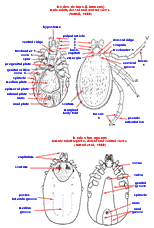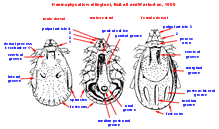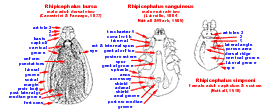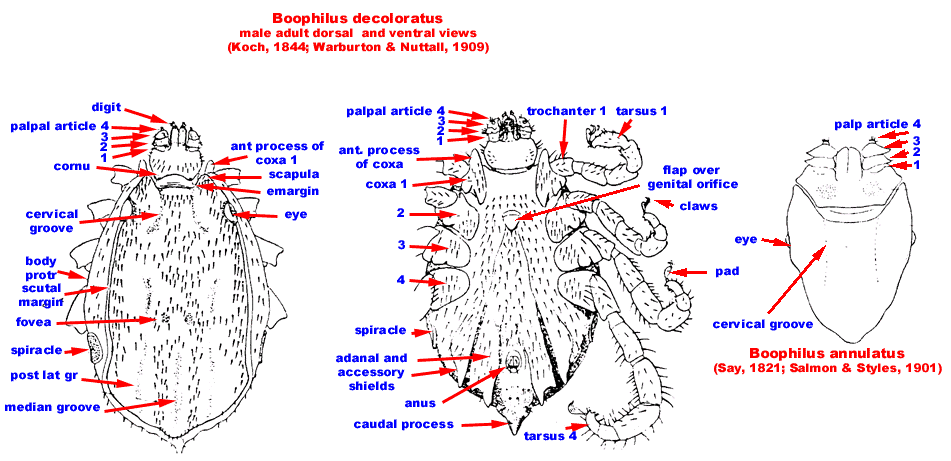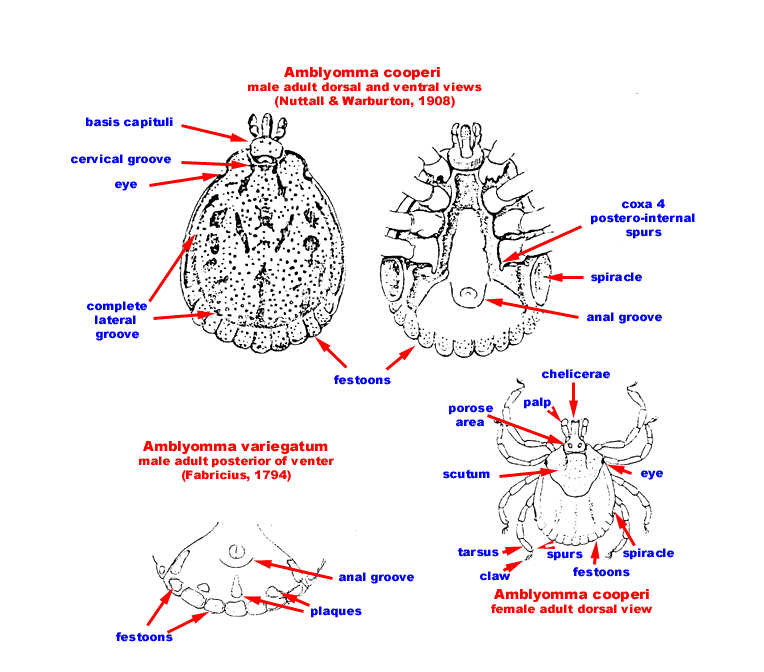IDENTIFICATION of the paralysis tick I. holocyclus and related ticks
The following page provides brief textual descriptions of the tick genera and a taxonomic key for identification. If you think you have a paralysis tick go straight to the page Ixodes holocyclus. For pictures showing the 4 ticks commonly found in eastern Australia see Distinguishing Common Ticks on the East Coast of Australia:- adult ticks, nymphs or larvae.
If you are unsure where to start here are some pointers:-
- You have a clearly visible insect-like parasite attached
to the skin

- If it has a long thin body with 3 obvious body sections
then it is most likely to be a louse.

- If it has an oval or triangular body without obvious body sections it is likely to be a tick.
- If the tick has a dorsal shield (scutum) and the mouthparts (capitulum) protrude forward when viewed from above, then it is a "hard" tick (an Ixodid tick). If there is no dorsal shield and the mouth parts are ventral then it is a "soft" tick (an Argasid tick). This page has a key to the genera of "hard" ticks and a key to the Australian Ixodes sp ticks
- If the tick has 6 barely visible legs and the body is also only pin-head size (< 1.5 mm) it is a larva stage tick, then go to Common larvae, or to the remainder of this page.
- If the tick has 8 small legs (<2mm long) and its body is only match-head size it is a nymph stage tick, then go to Common nymphs, or to the remainder of this page.
- If the tick has 8 long legs (>2mm long) and its body is match-head to pea size it is an adult stage tick, then go to Common adult ticks on the East Coast of Australia or to the remainder of this page.
- If you think you have a paralysis tick, you can confirm this by looking at the page identification anatomy of Ixodes holocyclus.
For more details on other ticks not pictured amongst the Common Ticks, see the key to the identification of the "hard" (Ixodid) ticks below.
The tick genera
Both the major tick families (ixodid and argasid) have 4 stages in the life cycle- egg, 6-legged larva, 8-legged nymph and 8-legged adult, and both with separate sexes. Transition from one stage to the next is via moulting (cuticle shedding) occurs after a blood meal. In argasids, however there may be variable numbers of of nymphal moulting stages (instars)- up to seven (Cupp, EW, 1991).
The genus Ixodes
The genus Haemaphysalis
The genus Rhipicephalus
The genus Dermacentor
The genus Boophilus
The genus Amblyomma
The genus Aponomma
Key to the genera of Ixodid ticks
Key to the Australian Ixodes sp ticks
References
The genus Ixodes.
Some 200 species of the genus Ixodes are found worldwide. Ixodes are three-host ticks. The long mouthparts of the females enable these ticks to be especially painful and annoying to domestic animals and humans.The anal groove is distinct and surrounds the anus anteriorly usually uniting in a point or arch. Palpi long. Palps and basis capitulum of variable forms. Inornate. Eyes and festoons absent. Ventral surface of the male armed with 7 non-projecting, armor like plates- pregenital , median, anal, and adanal shields, the latter two being paired. Stigmatic (spiracular) plates oval in male, circular in female.Sexual dimorphism pronounced, especially with regard to the capitulum. See also identification anatomy of Ixodes holocyclus and photograph of ventral aspect of Ixodes holocyclus.
Some species of Ixodes
Ixodes australiensis (indigenous tick)- WA and Tas
Ixodes cornuatus indigenous tick)- southeast coastal NSW, central Vic, Tas, may cause paralysis
Ixodes holocyclus [Neumann](paralysis tick)- Qld to Bairnsdale in Vic, causes paralysis. Found mostly on the east coast of Australia, also New Guinea, Indonesia and India; occurs on the long nosed bandicoot, echidna, opossum, man dogs, cats and other domestic animals; transmits Coxiella burnetii; causes paralysis, starting with the hind legs, then the forelegs, head and neck, and finally the muscles of respiration; recovered animals have a temporary immunity.
Ixodes hirsti [Hassall] (cat tick)- may cause paralysis ??
Ixodes kohlsi [Arthur] (penguin tick)
Ixodes ornithorhynci [Lucas] (platypus tick)
Ixodes tasmani [Neumann] (possum tick, opossum tick)- Tas, Vic, NSW, Qld, SA, WA
Ixodes trichosuri [Roberts] (possum Ixodes)
Ixodes myrmecobi (indigenous tick)- southwest of WA
Ixodes vestitus [Neumann] (numbat tick)
Ixodes fecialis
Ixodes ricinus: the "castor bean tick", common in Europe and some other countries; frequently found on dogs but also other domestic animals and wild mammals. Transmits several diseases including Babesia divergens and Babesia bovis (redwater of cattle), Anaplasma marginale, the viruses of louping ill and Rickettsial tick borne fever of sheep, Coxiella burnetii, Bukhovinian haemorrhagic fever. Also Lyme disease.
Ixodes persulcatus: a Eurasian form; transmits several species of Babesia. Also Lyme disease and Tick-borne encephalitis.
Ixodes hexagonus: the "hedgehog tick"; found on the hedgehog, dog, otter, ferret and weasel in Britain.
Ixodes pilosus: the russet or sourveld or "bush tick"; most areas of South Africa; hosts are cattle, sheep, goats, horses, dogs, cats and wild ungulates.
Ixodes rubicundus: the paralysis tick of South Africa (the Karoo paralysis tick); chief hosts are sheep, goats and cattle; other hosts are Artiodactyla, Carnivora, and Lagomorpha; immature stages feed on the red hare, elephant shrew, bush hare and wild Canidae (red jackal and dog); removal of the tick is in some instances, although not all, followed by recovery from tick paralysis caused by them.
Ixodes scapularis: the "shoulder tick" or "black legged ticked"; cattle, sheep, horses, dogs and cats in North America; in the South Atlantic, South Central, Southern North Central and North Atlantic States; may transmit anaplasmosis in some areas. Also Lyme disease.
Ixodes cookei: cattle in California and Oregon; horses in Massachusetts, and on dogs and cats in the South Eastern and North Eastern States of the USA and in South Eastern Canada.
Ixodes pacificus: the "California black legged tick"; occurs on cattle, sheep, horses, dogs and cats iin California, Oregon, Utah and British Columbia. Also Lyme disease.
Ixodes angustus: Oregon,, Washington; dogs
Ixodes kingi: the "rotund tick"; Idaho, Montana, Dakotas, Wyoming, Utah, Ontario; dogs.
Ixodes muris: the "mouse tick"; Maine; dogs.
Ixodes rugosus: California, Oregon, Utah, Washington; dogs.
Ixodes sculptus: Oregon, Wisconsin; dogs.
Ixodes texanus: Iowa, British Columbia; dogs.
The genus Haemaphysalis
The genus haemaphysalis includes approximately 150 species. Three- host ticks. Inornate. Eyes absent. Festoons present. Usually short conical palps with second segment projecting beyond lateral margin of basis capitulum. Basis capitulum rectangular in dorsal view. Usually small in size and sexual dimorphism slight. Ventral plates or shields absent in male. Posterior margin of coxa I never bifid or deeply cleft. Spiracular plates usually rounded or comma-shaped in male, rounded or oval in female.
Haemaphysalis longicornis (the "bush tick")
Haemaphysalis bancrofti (the "wallaby tick") is a very common species in coastal NSW and is commonly collected from animals.
The genus Rhipicephalus
The genus Rhipicephalus apparently originated in Africa, where some 60 species are now found. These ticks are especially important as reservoirs and vectors of a variety of animal diseases. Palps short. Basis capitulum usually hexagonal dorsally. Usually inornate. Eyes and festoons present. Coxa I deeply cleft. Males with adanal shields and usually accessory shields. Spiracular plates comma-shaped. Caudal process present or absent in male.
e.g.For biological behaviour see Rhipicephalus sanguineus (the brown dog tick), and for detailed pictures see Rhipicephalus sanguineus - anatomical description
The genus Dermacentor
The genus Dermacentor comprises an important group of Ixodid ticks iin the United SDtates, particularly as vectors of disease producing organsisms affecting humans. Several of the species are directly associated with Rocky Mtn Spotted Fever, tularaemia, Colorado tick fever, and Q fever. The salivary secretions of some species may produce tick paralysis. Several members of this genus also are important pests of animals, both as disease vectors and as blood-sucking parasites. Basis capitulum rectangular dorsally. Eyes and festoons present. Palps short, broad or moderate. Coxae I to IV of males increase progressively in size. In all species coxa IV is the largest. Male without ventral plate or shields. Coxa I bifid in both sexes. Spiracular plates suboval or comma-shaped. Usually ornate.
The genus Boophilus
Ticks of the genus Boophilus are important for their economic impact on cattle in Australia. Very short, compressed palps, ridged dorsally and laterally. Basis capitulum hexagonal dorsally. Eyes present. Inornate. Festoons absent. Spiracular plate rounded or oval. Male with adanal shields and accessory shields. Anal groove indistinct or absent in female, faint in male. Caudal process present or absent in male.
Boophilus microplus is the only species in Australia and is economically very important. There is a vaccine available against this tick which was developed by CSIRO. See the NSW government site the cattle tick
The genus Amblyomma
In Australia-
Amblyomma albolimbatum [Neumann] stumpy-tailed lizard tick
Amblyomma moreliae (Koch) snake tick
Amblyomma triguttatum [Koch] ornate kangaroo tick
The genus Aponomma
Aponomma aurunginans (wombat tick)- southeastern Australia, rare on dogs
KEY TO IDENTIFICATION OF THE IXODID (HARD, SCUTATE) TICKS
Note that Ixodid ticks are all those ticks which have a dorsal shield (scutum). The genus Ixodes represents only one of the subgroups of Ixodid ticks
Key to developmental stages (Hoskins, 1991)
1. Six legs present > larva
Eight legs present > 2.
2. Genital aperture not present (undeveloped); scutum similar to female > nymph
Genital aperture present; porose areas on basis capitulum of female > adult
Key to the genera of adult Ixodidae
1. Anal grooves distinct and surrounds the anus anteriorly (Prostriata), inornate, eyes and festoons absent > Ixodes.
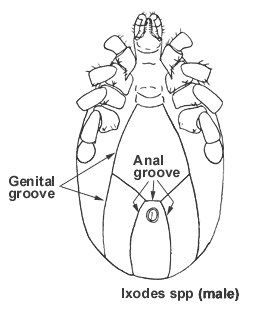
Anal grooves surrounding the anus posteriorly only (Metastriata) or absent; ornate or inornate; eyes present or absent; festoons present or absent > 2.
2. Second segment of palps projects forward beyond lateral margin of basis capitulum; eyes absent > Haemaphysalis.
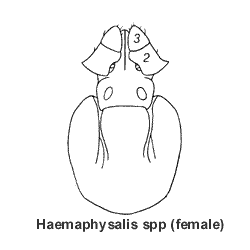
Second segment of palps not projecting beyond lateral margin of basis capitulum; eyes usually present > 3
3. Basis capitulum hexagonal; usually inornate > 4
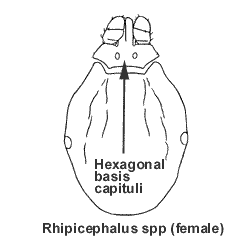
Basis capitulum not hexagonal dorsally; ornate or inornate > 7
4. Festoons present; spiracular plate comma shaped or sub triangular; coxa 1 deeply cleft (ie bifid) > 5
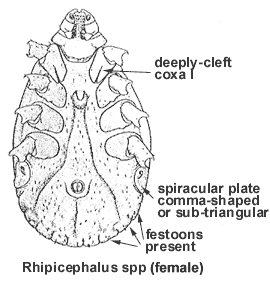
Coxa 1 not deeply cleft in female > 6.
5. Males with adanal shields and usually accessory shields; coxa IV of male of normal size; segment 1 of palps without dorsal spur > Rhipicephalus.


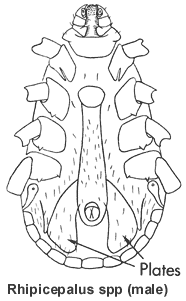
Males without adanal and accessory shields ; coxa IV of male greatly enlarged; segment of palps with dorsal spur > Rhipicentor
6. Palps very short, compressed and ridged dorsally and laterally; males with normal legs > Boophilus.
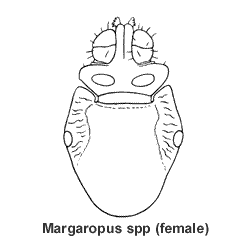
7. Palps short, second segment not twice as long as wide; basis capitulum rectangular dorsally > Dermacentor.
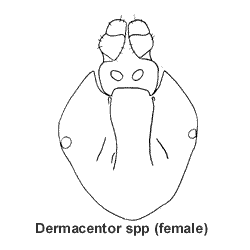
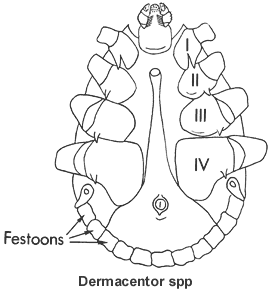
Palps long, second segment twice as long as wide; basis capitulum of variable form, usually subtriangular or subrectangular dorsally > 8.
8. Eyes present > 9
Eyes absent or rudimentary; species occuring almost exclusively on reptilia > Aponomma.
9. Scutum inornate; festoons poorly developed (often coalesced); males with adanal shields, accessory shields, usually subanal shields > Hyalomma.
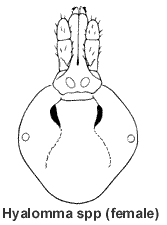
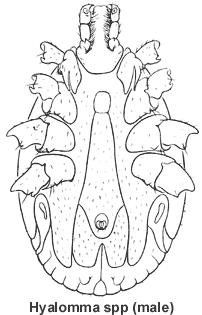
Scutum usually ornate, festoons well developed; males without adanal shields (but small plaques may be present on the venter near the festoons), accessory shields, and subanal shield > Amblyomma.
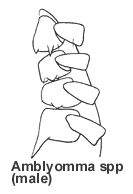
KEY TO THE AUSTRALIAN Ixodes sp TICKS (Roberts, 1960)
Males (the males of victoriensis,
australiensis, hydromyidis, vestitus, ornithorhynchi, eudyptidis,
pterodromae, and simplex simplex have not been described)
Females
Nymphs (the nymphs of confusus,
cornuatus, hirsti, and victoriensis have not been
described)
Larvae (the larvae of confusus,
cornuatus, hirsti, antechini, fecialis, australiensis,
pterodromae and victoriensis have not been described)
Note: The following linked pages of individual species have not all been completed. Note also that this information may not be current as it is based on "Roberts FHS (1960): A systematic study of the Australian species of the genus Ixodes (Acarina: Ixodidae). Australian Journal of Zoology 8:392-485."
Males
1. Body with 5 posterior brushes of hairs (sea bird habitats) > I. uriae
Body without such brushes of hairs > 2
2(1). Legs inordinately long, much longer than body (bat habitats) > I. vespertilionis
Legs not as above > 3
3(2). Lateral grooves distinct but not necessarily complete > 4
Lateral grooves absent > 8
4(3). Scutum with lateral carinae > 5
Scutum without lateral carinae > 6
5(4). Trochanters with spurs > I. confusus
Trochanters devoid of spurs > I. hirsti
6(4). Lateral grooves completely encircling scutum, or almost so > 7
Lateral grooves apparent posteriorly only > I. trichosuri
7(6). Body measurements at least 3.0 by 2.5 mm > I. cornuatus
Body measurements less than 3. 0 by 2. 5 mm > I. holocyclus
8(3). Article 1 of palpi greatly enlarged, extending inwardly and anteriorly to ensheathe base
of mouthparts > I. tasmani
Article 1 of palpi not as above > 9
9(8). Anal plate constricted medianly; hypostome bilobed distally, dentition greatly reduced
(sea bird habitats) > I. kohlsi
Anal plate not, constricted medianly; hypostome and dentition not as above > 10
10(9). Small, narrowly oval ticks, hypostome dentition 2/2 > 11
A medium-sized, broadly oval tick; hypostome dentition mainly 4/4 and 3/3 (sea bird
habitats) > I. rothschildi
11 (1 0).Coxa I with a small external spur > I. antechini
Coxa without such a spur > I. fecialis
Females
1. Legs inordinately long, giving a spidery effect > I. vespertilionis
Legs not as above
2(1). Anal grooves meeting posteriorly
Anal grooves widely separated posteriorly > 8
3(2). Palpal article 1 greatly enlarged, ensheathing base of mouthparts, capitulum short > I. australiensis
Palpal article 1 not as above; capitulum long > 4
4(3). Sternal plate present
Sternal plate absent
5(4). Coxae with > 6
Coxae smooth > I. trichosuri
6(5). Basis capituli with 3 carinae dorsally and ventrally; trochanters with spurs > I. confusus
Basis capituli with only 2 carinae dorsally and ventrally; trochanters without spun > I. hirsti
7(4). Basis capituli with well-defined bluntly pointed cornua > I. cornuatus
Basis capituli with at most only shallow rounded cornua > I. holocyclus
8(2). Hypostome dentition 2/2 > 9
Hypostome dentition more than 2/2, particularly in distal area > 12
9(8). Scutum widest anteriorly, palpal article 3 broader than palpal article 2 (sea birds) > I. uriae
Scutum widest towards or posterior to mid-length, palpal article 3 not broader than palpal
article 2 > 10
10(9). Scutum wider than long and widest towards mid-length > I. vestitus
Scutum longer than wide and widest posteriorly > 11
11(10).PaIpal article 1 triangular, scutum only a little longer than wide; coxa I unarmed > I. fecialis
Palpal article I somewhat rectangular, scutum almost twice as long as wide, coxa I with
small, but distinct, external spur > I. antechini
12(8). Palpal article 1 greatly enlarged and ensheathing base of mouthparts > 13
Palpal article 1 not as above > 15
13(12).Basis capituli with cornua; coxae with spurs > I. victoriensis
Basis capituli without cornua; coxae without spurs > 14
14(13).Scutum a little longer than wide, punctations fine; porose areas superficial > I. hydromyidis
Scutum wider than long, punctations numerous and relatively coarse; porose areas
well defined > I. tasmani
15(12).Coxae with spurs (sea birds) > 17
Coxae without spurs > 16
16(15).Scutum longer than wide; hypostome dentition with 4 rows of 3/3 (bats) > I. simplex simplex
Scutum wider than long; hypostome dentition with about 7-8 rows of 3/3 > I. ornithorhynchi
17(15).Article 1 of palpi with a strong, internal, anteriorly directed horn-like protrusion and a
distinct mesodorsal spur (sea birds) > I. pterodromae
Article 1 of palpi not as above > 18
18(17).Basis capituli with cornua > 19
Basis capituli without cornua > I. eudyptidis
19(18).Anal grooves markedly constricted posteriorly (sea birds) > I. kohlsi
Anal grooves at most only slightly constricted posteriorly (sea birds) > I. rothschildi
Nymphs
1. Legs inordmately long, giving a spidery effect (bats) I. vespertilionis
Legs not as above > 2
2(1). Sternal plate present > 3
Sternal plate absent > 4
3(2). Anal grooves narrowly open posteriorly; hypostome bluntly pointed, dentition 3/3 and 2/2 > I. holocyclus
Anal grooves closed posteriorly; hypostome acutely pointed, dentition 2/2 > I. trichosuri
4(2). Scutum with lateral carinae > 5
Scutum without lateral carinae > 8
5(4). All coxae with spurs. (sea birds > I. rothschildi
At most only 1 coxa with spur > 6
6(5). Scutum much longer than wide; coxa with a small but distinct external spur > I. antechini
Scutum at most little longer than wide; coxa I unarmed > 7
7(6). Article 1 of palpi triangular > I. fecialis
Article 1 of palpi somewhat discoidal > I. vestitus
8(4). Palpal article 1 greatly enlarged and ensheathing base of mouthparts > 9
Palpal article 1 not as above > 11
9(8). Coxae armed > I. australiensis
Coxae unarmed > 10
10(9). Scutum with few and fine punctations; cervical grooves not attaining posterior margin
of scutum I. hydromyidis
Scutum with numerous, relatively coarse punctations; cervical grooves running full
length of scutum I. tasmnani
11(8). Palpal article 1 extending inwardly and anteriorly as a well-developed spur (sea birds) >
Palpal article 1 without such a spur > 12
12(1 1).Coxae armed > 13
Coxae unarmed > 14
13(12).Basis capituli with cornua (sea birds) > I. kohlsi
Basis capituli without cornua (sea birds) I. eudyptidis
14(12).Hypostome dentition with rows at most 2/2 > 15
Hypostome dentition with rows of 3/3 (bats) I. simplex simplex
15(14).Palpal article 3 wider than palpal article 2; scutum with greatest width anteriorly (sea birds) > I. uriae
Palpal article 3 not wider than palpal article 2; scutum with greatest width near mid-length > I. ornithorhynchi
Larvae
1. Coxae with spurs > 8
Coxae without spurs > 2
2(1). On bats > 3
On other hosts > 4
3(2). Tarsi 0. 13 mm in length > I. simplex simplex
Tarsi 0. 34-0.44 nun in length > I. vespertiolionis
4(2). Palpal article 1 enlarged and extending inwardly to base of mouthparts > 5
Palpal article 1 not as above > 6
5(4). Cervical grooves well defined, attaining posterior margin of scutum I. tasmani
Cervical grooves faint and not attaining posterior margin of scutum I. hydromyidis
6(4). Scutum longer than wide and widest anterior mid-length, (sea birds) > I. uriae
Scutum wider than long and widest near or posterior to mid-length > 7
7(6). Scutum with lateral carinae > I. vestitus
Scutum without lateral carinae > I. ornithorhynchi
8(1). Scutum widest well anterior to mid-length (sea birds) > 9
Scutum widest near mid-length > 11
9(8). Basis capituli with cornua > I. kohlsi
Basis capituli without cornua > 10
10(9). Scutum wider than long > I. eudyptidis
Scutum longer than wide > I. rothschildi
11(8). Coxe, III with a small spur > I. holocyclus
Coxa III unarmed > I. trichosuri
Bibliography
Commonwealth Scientific and Industrial Reasearch Organisation (C.S.I.R.O.): Scientific and Common Names of Insects and Allied Forms Occurring in Australia; Bulletin No 287, C.S.I.R.O. Australia, 1973.
The Board of Tick Control, NSW AGRICULTURE AG dex 662, 1993.
Hoskins, JD: Ixodid and Argasid Ticks, Keys to Their Identification, in The Veterinary Clinics of North America, Small Animal Practice, Vol 21:1 Tick Transmitted Diseases, 1991.
Kelly, JD: Canine Parasitology, Veterinary Review No 17; The Post-Graduate Foundation in Veterinary Science, University of Sydney, 1977.
Nuttal GHF, Warburton C, Cooper WF, Robinson LE; Ticks, A Monograph of the Ixodoidea, Cambridge University Press, 1908.
Roberts, FHS (1960) A systematic study of the genus Ixodes (Acarina: Ixodidae)
Roberts, F.H.S. (1970). Australian Ticks. CSIRO, Melbourne.
Roberts, F.H.S. (1969). The larvae of Australian Ixodidae (Acarina: Ixodoidea). Journal of the Australian Entomological Society, 8: 37-78.
Soulsby, E J L; Helminths, Arthropods and Protozoa of Domesticated Animals; Bailliere Tindall and Cassell, London, 6th ed, 1968.
The Paralysis Tick of Australia - Home
E-mail Us to report a broken link!
